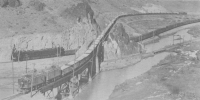|
As the last transcontinental line to
reach the Pacific, the Chicago, Milwaukee and St. Paul (as it was then
called) had at its disposal in the first decade of the 20th Century a
vastly different level of technology than was available to earlier
transcontinental builders.
By 1909, limited electrifications
 for
terminal and tunnel operations had been proved feasible elsewhere. At the
same time, commercial demand for electricity was growing and the vast
potential for hydro-electric power in western states was being developed.
With this technology available, the possibility of electrical operation
was considered as early as 1905 and 1906 while land for the extension was
being acquired. for
terminal and tunnel operations had been proved feasible elsewhere. At the
same time, commercial demand for electricity was growing and the vast
potential for hydro-electric power in western states was being developed.
With this technology available, the possibility of electrical operation
was considered as early as 1905 and 1906 while land for the extension was
being acquired.
As they planned and surveyed the route,
officials and construction engineers learned for themselves the benefits
which electrification could provide. The long distances to Midwestern coal
supplies, an abundance of hydroelectric potential close at hand, the long,
severe winters and difficult terrain all underscored the advantages of
electrifying.
As a result of these early
considerations, parcels of land were purchased and set aside for possible
electrical substations, and flow rights for generating dams were secured,
all before the extension was completed.
But construction of the extension as a
conventional railroad proceeded. Having the experience of earlier westward
builders to draw on, and having the advantage of the Northern Pacific
Railroad already close by to bring materials to work crews, construction
of the extension proceeded remarkably well. Well-planned and highly
organized, the 1,400-mile Pacific extension project was completed in
slightly more than three years, from Glenham, S.D., to Seattle.
Limited operations were underway in some
places in 1908 and the line was opened from Chicago to Seattle in 1909.
However, the problems of operating steam locomotives year-round through
the mountains in Montana and Idaho all too soon became apparent.
Steep grades, constant curvature and
frequent tunnels made steam operation on the extension trying even in good
weather. But long, bitter cold winters, bringing heavy snowfall and
temperatures as low as 40 degrees below zero, compounded the difficulties.
In cold weather, steam locomotives were extremely difficult to maintain,
often suffered significant power losses, and sometimes simply wouldn’t
run. Even in good weather, mountain grades and curves caused steam
locomotives to lose a great deal of power.
The success of two other electrification
projects in the Milwaukee’s territory brought further impetus for
electrifying. In 1909, the Great Northern electrified its line through the
Cascade Tunnel, and demonstrated the superiority of electric over steam
operation in the difficult winter conditions. Of more direct impact was
the highly successful electrification of the ore-carrying Butte, Anaconda
and Pacific Railroad which connected with the Milwaukee. Watching the BA&P
work out the problems of mountain electrification on a small scale,
Milwaukee officials became certain that it could be done larger and
better. |
|
|
Years of the nation's transcontinental
completions:
1869 Union Pacific
1883 Northern Pacific
1893 Great Northern
1909 Milwaukee
Hydro-electric power abundant in western states
The nearby Northern Pacific Railroad brings materials
Operational
challenges:
- steep
grades
- constant curvature
-
frequent tunnels
- heavy
snowfall
1909
The
Great Northern electrified its Cascade Tunnel
|
